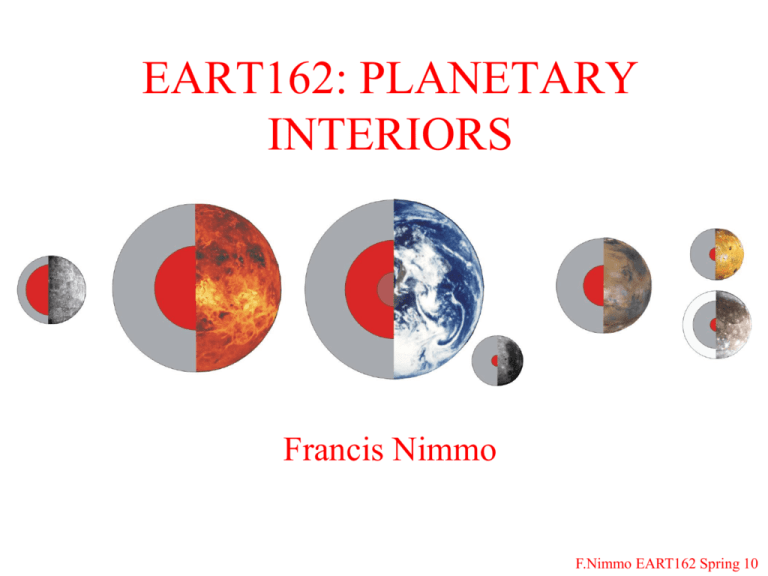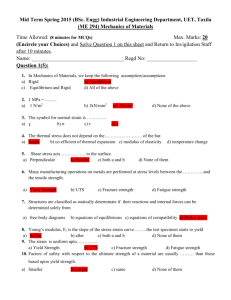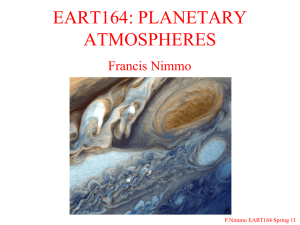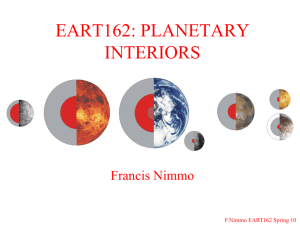Powerpoint slides - Earth & Planetary Sciences
advertisement

EART162: PLANETARY INTERIORS Francis Nimmo F.Nimmo EART162 Spring 10 Last Week • Global gravity variations arise due to MoI difference (J2) • We can also determine C, the moment of inertia, either by observation (precession) or by assuming a fluid planet • Knowing C places an additional constraint on the internal mass distribution of a planet (along with bulk density) • Local gravity variations arise because of lateral differences in density structure • To go from knowing the mass/density distribution to knowing what materials are present, we need to understand how materials behave under planetary interior conditions . . . F.Nimmo EART162 Spring 10 This Week – Material Properties • How do planetary materials respond to conditions in their interiors? • Atomic description of matter • Elastic properties – Basic concepts – stress and strain, Hooke’s law – Elastic parameters • Equations of state • Viscous properties – Basic concepts – stress and strain rate – Flow law • See Turcotte and Schubert chapters 2,3,7 F.Nimmo EART162 Spring 10 Atomic Description Long-range attraction Energy Short-range repulsion Binding 0 energy Lattice spacing Equilibrium spacing • Equilibrium lattice spacing is at energy minimum (at zero temperature) • Binding energy is amount required to increase lattice spacing to infinity • To increase or decrease the lattice spacing from the eqbm. value requires work • So deforming (straining) a solid requires work to be done, in other words we have to apply a stress • Macro-scale properties of a solid are determined by its atomic properties. An example: F.Nimmo EART162 Spring 10 Energy 0 Thermal Expansivity bA b0 b1 bB • Above 0 K, the lattice Lattice spacing energy includes a kinetic energy component (=3/2 kT, where k is Boltzmann’s constant) • The lattice will disaggregate (melt) when 3/2 kT ~ the binding energy of the lattice • When kinetic energy is added, the mean lattice spacing is (bA+bB)/2 = b1 > b0 • So the lattice will expand when it is heated • The macroscopic thermal expansivity a=(DL / L) /DT depends on the atomic properties of the material F.Nimmo EART162 Spring 10 Stress and Strain • These are the fundamental macroscopic quantities describing deformation • Stress is the applied force per unit area which is causing the deformation (units Nm-2=Pa) • Strain is the relative length change in response to the applied stress (dimensionless) • In general, compressional stresses and strains will be taken as positive, extension as negative (other people may use the opposite convention!) F.Nimmo EART162 Spring 10 Stress (s) • Normal stress: s = F / A (stress perpendicular to plane) F A • Example: mass of overburden per unit area = rh, so pressure (stress) = rgh • Shear stress: s = F / A (stress parallel to plane) h r F A • In general, a three-dimensional stress distribution will involve both normal and shear stresses F.Nimmo EART162 Spring 10 Strain (e) L DL • Normal strain e=DL / L (dimensionless) • In three dimensions D, the fractional change in volume, =DV/V=ex+ey+ez • Shear strain exy involves rotations (also dimensionless) x wy e xy = (1 2 ) dx 1 2 1 y 2 wx dy = 1 wy wx 2 x y Note that exy=eyx 1 wy wx 2 x y • Amount of solid body rotation w is • If w=0 then there is no rotation – pure shear F.Nimmo EART162 Spring 10 Elasticity • Materials which are below about 70% of their melting temperature (in K) typically behave in an elastic fashion failure stress yielding plastic elastic strain • In the elastic regime, stress is proportional to strain (Hooke’s law): e= s E • The constant of proportionality E is Young’s modulus • Young’s modulus tells us how resistant to deformation a particular material is (how much strain for a given stress) • Typical values of Young’s modulus are 1011 Pa (for rock) and 1010 Pa (for ice) F.Nimmo EART162 Spring 10 s1 e1 e3 s1 Uniaxial Stress • Unconfined materials will expand perpendicular to the e2 applied stress s2=s3=0 • Amount of expansion is given by Poisson’s ratio n • What is an example of a material s1 with a negative value of n? e1 = E e 2 = n E s e 3 = n E 1 Note convention: compression is positive • A material with n=1/2 is incompressible. What does this mean? • Geological materials generally have n =1/4 to 1/3 F.Nimmo EART162 Spring 10 Plane Stress • If we have two perpendicular stresses, we get plane stress • Results can be obtained by adding two uniaxial stress cases (previous slide) • We will use these results in a while, when we consider flexure e1 s2 s 1 e3 e2 s3=0 e1 = E1 (s 1 ns 2 ) e 2 = E1 (s 2 ns1 ) e 3 = Ev (s 1 s 2 ) • Extension to three dimensions is straightforward: e1 = s 1 s 2 s 3 1 E v E v E Et cetera . . . F.Nimmo EART162 Spring 10 Pure Shear and Shear Modulus s s • Pure shear is a special case of plane stress in which s1=-s2 and the sx stresses normal to the object are zero • You can see this by resolving s1 and s2 onto x or y • • • • 1 y 45o s2 x y sxy You can also see that the shear stresses sxy = s1 = -s2 From the previous slide we have e1=(1+v)s1/E=(1+v)sxy/E In this case, e1=exy so sxy=Eexy/(1+v) We can also write this as sxy = 2G exy where G is the shear modulus and is controlled by E and n: E G= 2(1 v) F.Nimmo EART162 Spring 10 Bulk Modulus • Isotropic stress state s1=s2=s3=P where P is the pressure • If the stresses are isotropic, so are the strains e1=e2=e3 • Recall the dilatation D=e1+e2+e3 and gives the fractional change in volume, so here D=3e1 • From before we have e1 = E1 s 1 Ev s 2 Ev s 3 = E1 (1 2v) P E D = KD • So we can write P = 3(1 2v) • Here K is the bulk modulus which tells us how much pressure is required to cause a given volume change and which depends on E and n (like the shear modulus) • The definition of K is dV = dr = dP V r K F.Nimmo EART162 Spring 10 Example • Consider a column that is laterally unconstrained i.e. in a uniaxial stress state • Vertical stress s = r g z • Strain e(z) = r g z / E • To get the total shortening, we integrate: a h dh = edz = 0 z h rgh 2 2E E.g. Devil’s Tower (Wyoming) h=380m, dh=2cm What kind of geological formation is this? F.Nimmo EART162 Spring 10 Summary • Elasticity involves the relationship between stress s and strain e • The two most important constants are the Young’s modulus E and Poisson’s ratio n • Hooke’s law: s = E e • Other parameters (shear modulus G, bulk modulus K) are not independent but are determined by E and n sxy = 2G exy dr dP = r K The shear modulus G is the shear equivalent of Young’s modulus E The bulk modulus K controls the change in density (or volume) due to a change in pressure F.Nimmo EART162 Spring 10 Hydrostatic equation • To determine planetary interior structure, we need to understand how pressure changes with depth • Consider a thin layer of material: r dz • We have dP = r g dz • This gives us P=rgh (if g and r are constant!) • This is the equation for hydrostatic equilibrium (the material is not being supported by elastic strength or fluid motion) • Hydrostatic equilibrium is a good assumption for many planetary interiors F.Nimmo EART162 Spring 10 Equations of State • What is an equation of state? • It describes the relationship between P, T and V (or r) for a given material • Why is this useful? • P and T both change (a lot!) inside a planet, so we would like to be able to predict how r varies • Example – ideal gas: PV = P / r = RT Note that here V is the specific volume, so r = 1/V • This allows us to e.g. predict how pressure varies with a altitude (scale height) • Similar results may be derived for planetary interiors F.Nimmo EART162 Spring 10 EoS and Interiors (1) • Recall the definition of bulk modulus K: dP dP K = V =r dV dr • This is an EoS which neglects T (isothermal) • Why is it OK to neglect T (to first order)? • We can use this equation plus the hydrostatic assumption to obtain (how?): 2 r g a dr = dz K • Does this equation make sense? F.Nimmo EART162 Spring 10 EoS and Interiors (2) dr = r 2g K dz The problem with this equation is that both g and K are likely to vary with depth. This makes analytical solutions very hard to find. If we make the (large) assumption that both g and K are constant, we end up with: a r 1 = r 0 1 r Kgz 0 This approach is roughly valid for small bodies where pressures are low (r0gR << K) What is the maximum size planet we could use it for? K surface ~150 GPa F.Nimmo EART162 Spring 10 EoS and Interiors (3) • In the previous slide we assumed a constant bulk modulus (now called K0) • The next simplest assumption is that K=K0+K0’P where K0’=dK/dP|P=0 (~4 for geological materials) • We can use this assumption to get Murnaghan’s EOS: 1/ K 0' a K 0' r = r 0 1 P K0 • This is more realistic but can’t be used to obtain analytical solutions (why not?) F.Nimmo EART162 Spring 10 Example - Earth Dashed lines are theory, solid lines are seismicallydeduced values. Theory assumes constant g and K: r 1 = r 0 1 r Kgz 0 Figure from Turcotte & Schubert, 1st ed. (1982) • Note that the very simple EoS assumed does a reasonable job of matching the observed parameters • What are the reasons for the remaining mismatch? F.Nimmo EART162 Spring 10 Example - Io • Io bulk density 3.5 g/cc, mantle surface density 3.3 g/cc • What would the density of mantle material be at the centre of Io? r 1 r0 = 1 r 0Kgz • K~1011 Pa, R~1800 km, g=1.8 ms-2 so rcentre~3.7 g/cc • What approximations are involved in this calculation, and what is their effect? • Bulk density is skewed to surface density (because of greater volume of near-surface material) • For a linear variation in r, rbulk=r0 + (rcentre-r0)/3 a • So predicted bulk density is 3.43 g/cc • So what do we conclude about Io? F.Nimmo EART162 Spring 10 Summary • Equations of state allow us to infer variations in pressure, density and gravity within a planet • The most important variable is the bulk modulus, which tells us how much pressure is required to cause a given change in density • The EoS is important because it allows us to relate the bulk density (which we can measure remotely) to an assumed structure e.g. does the bulk density imply the presence of a core? • Calculating realistic profiles for P,r,g is tricky because each affects the others F.Nimmo EART162 Spring 10 Flow • At temperatures > ~70% of the melting temperature (in K), materials will start to flow (ductile behaviour) • E.g. ice (>-80oC), glass/rock (>700oC) • Cold materials are elastic, warm materials are ductile • The basic reason for flow occurring is that atoms can migrate between lattice positions, leading to much larger (and permanent) deformation than the elastic case • The atoms can migrate because they have sufficient (thermal) energy to overcome lattice bonds • This is why flow processes are a very strong function of temperature F.Nimmo EART162 Spring 10 Examples of Geological Flow Mantle convection Glaciers Salt domes Lava flows ~50km F.Nimmo EART162 Spring 10 Flow Mechanisms • For flow to occur, grains must deform • There are several ways by which they may do this, depending on the driving stress • All the mechanisms are very temperature-sensitive Increasing stress / strain rate Diffusion creep (n=1, grain-size dependent) Grain-boundary sliding (n>1, grain-size dependent) Dislocation creep (n>1, indep. of grain size) Here n is an exponent which determines how sensitive to strain rate is to the applied stress. Fluids with n=1 are called Newtonian. F.Nimmo EART162 Spring 10 Atomic Description No. of particles • Atoms have a (Boltzmann) Peak = kT/2 distribution of kinetic energies Mean= 3kT/2 • The distribution is skewed – there is a long tail of highEnergy E energy atoms • The fraction of atoms with a kinetic energy greater than a particular value E0 is: E0 f ( E0 ) = 2 exp( E0 / kT ) kT • If E0 is the binding energy, then f is the fraction of atoms able to move about in the lattice and promote flow of the material • So flow is very temperature-sensitive F.Nimmo EART162 Spring 10 Elasticity and Viscosity • Elastic case – strain depends on stress (Young’s mod. E) e =s / E • Viscous case – strain rate depends on stress (viscosity m) e = s / m • We define the (Newtonian) viscosity as the stress required to cause a particular strain rate – units Pa s • Typical values: water 10-3 Pa s, basaltic lava 104 Pa s, ice 1014 Pa s, mantle rock 1021 Pa s • Viscosity is a macroscopic property of fluids which is determined by their microscopic behaviour F.Nimmo EART162 Spring 10 Viscosity in action • Definition of viscosity is stress / strain rate • For a typical terrestrial glacier m=1014 Pa s. • Typical stresses driving flow are ~1 MPa (why?) velocities Strain rate = stress / visc = 10 -8 s-1 Centre-line velocity ~ 10-5 m s-1 ~ 0.3 km per year glacier (Velocity profile is not actually linear because of nonNewtonian nature of ice) ~1km • Temperature-dependence of viscosity is very important. E.g. • Do glaciers flow on Mars? • How can the Earth’s mantle both convect and support surface loads simultaneously? F.Nimmo EART162 Spring 10 Summary • Flow law describes the relationship between stress and strain rate for geological materials • (Effective) viscosity is stress / strain rate • Viscosity is very temperature-dependent F.Nimmo EART162 Spring 10








